Top News

September 10, 2020 Ryukyu Shimpo
By Hironori Sunakawa
“We use a special key to open the door to peace.” So begins the poem The Door to Peace, written by Maharo Kitakado, 10, a fifth-grade student at AMICUS International School in Uruma City. The poem was printed in the Ryukyu Shimpo’s June 23 special issue commemorating the 75th anniversary of WW 2. In early August, Kitakado received a CD containing gospel music composed to her poem.
The composer is Tomoko Ishikawa, a Niigata Prefecture resident and an organist at the Niigata United Church of Christ in Japan (Nippon Kirisuto Kyodan). On June 23, her pastor shared with her the poem printed in the Shimpo’s special issue.
A letter accompanied the CD, in which Ishikawa wrote: “I was touched by your wonderful poetry. Your words were simple and warm. It teaches us what we can do for peace.” Ishikawa explained that she began to hear a melody as she re-read the poem over and over again.
In the letter, the organist asked for Kitakado’s permission to perform the song during church service. Kitakado said, “I am happy to know I can touch people’s hearts.”
The two spoke over the phone; Kitakado is a choir member and told Ishikawa she would like to sing the song herself.
Many Shimpo readers responded to Kitakado’s poem printed in the Okinawa Memorial Day special issue; One reader sent Kitakado the poem framed and written in calligraphy.
The poem ends with the line: “75 years since, when will the door to peace open for Okinawa?” Kitakado’s words speak to all who seek peace.
(English translation by T&CT and Monica Shingaki)
Go to Japanese

September 10, 2020 Ryukyu Shimpo
Concerning the investigation in which the flight paths of U.S. military aircraft that took off from and landed at Futenma Air Station were recorded, on September 9 in the Okinawa Defense Bureau (ODB) newsroom, the ODB released a 2019 month-by-month map of the planned air routes. These records confirm that there were flight paths that differed from the air routes previously agreed upon by the governments of the United States and Japan.
The month-by-month air route map was released before this point on the ODB website on the internet, but was removed from the website per the wishes of the U.S.military. Given that the details in these reports could no longer be read, it became an issue of the retraction of access to information. Following the U.S. military helicopter crash at Okinawa International University in 2004, the governments of the United States and Japan established revised flight paths so as to avoid using airspace over private land to the extent possible.
In an interview with the Ryukyu Shimpo on September 9, a spokesperson for the ODB explained: “It is presumed that flying on flight paths outside of air routes may be unavoidable due to weather conditions such as cloudiness and wind. Generally, flight paths did follow the air routes”.
Meanwhile, the governments of the United States and Japan have requested that the U.S. military act to follow air routes and safety measures, and also requested noise reductions. The U.S. military has responded by instructing crewmembers that maintaining safety during flight is to be prioritized. The month-by-month air routes map can be seen in the ODB first-floor newsroom during the hours of 9:00 a.m.-noon and 1:00-5:00 p.m., excluding weekends and national holidays.
(English translation by T&CT and Erin Jones)
Go to Japanese

September 11, 2020 Ryukyu Shimpo
PD AeroSpace is an Aichi-based company working in spacecraft development. On September 10, this company signed a letter of intent with Okinawa Prefecture to develop spaceport capabilities at Shimojishima Airport in Miyakojima, which has a 3000-meter runway. PD AeroSpace plans to begin manned space flights departing from Shimojishima Airport in 2025. At earliest they will begin test flights with unmanned spacecraft in December of this year and proceed to build hangars in the summer of 2021.
PD AeroSpace was founded in 2007. The company aims to enable space tourism aboard winged space shuttles (space planes) and is currently developing an unmanned spacecraft. They have received funding from ANA Holdings and H.I.S., a major travel agency.
The plane that PD AeroSpace aims to develop will be different from launched space shuttles. This plane will take off horizontally, like an airplane, and will rise perpendicular to earth starting at an altitude of 15 km. The company plans for future space tours to take approximately 90 minutes from take-off to landing. The target audience is the super-rich of the world with an expected price tag between 14 and 15 million yen.
PD AeroSpace determined that Shimojishima Airport, with its 3000-meter runway and the training areas to the north and south, was a suitable spaceport. They aim to send 100 space tourists into space from Shimojishima in 2025, and 1000 people annually in 2030.
Shuji Ogawa, representing PD AeroSpace, says, “We want to make full use of the island’s unique qualities as we expand this business. In addition to a space development hub, we want to work with everyone in the space business to make Shimojishima a hub for all aspects of the space industry.”
They envision the development of a variety of businesses that will bring domestic and international companies working in the space sector. These include property rental, training for space tourists, and tourism opportunities showing test flights. There are also plans to establish a consortium centered around PD AeroSpace with travel companies and airlines in Okinawa and elsewhere, tentatively called The Shimojishima Spaceport Business Promotion Consortium.
(English translation by T&CT and Ellen Huntley)
Go to Japanese
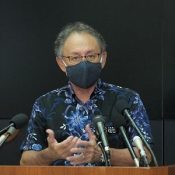
September 7, 2020 Ryukyu Shimpo
On September 7, Okinawa’s Governor Denny Tamaki spoke critically with regard to the revelation that a barbecue held by U.S. soldiers was the cause of the fluorocarbon (PFAS)-containing firefighting foam leak from Marine Corps Air Station Futenma in April, saying, “I truly have no words.” Governor Tamaki pointed out, “There are various forms of effort to raise morale, but everyone must have an intuitive awareness of the appropriate place for such efforts as a matter of course.” He further added, “We must not let another event occur that spreads apprehension among Okinawans. I want [the U.S. military] to be strictly prudent.”
(English translation by T&CT and Sandi Aritza)
Go to Japanese
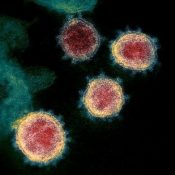
September 9, 2020 Ryukyu Shimpo
The strain of coronavirus that spread through Okinawa’s main island in mid-July was discovered to be similar to what was being found in Tokyo. After making a request to the National Institute of Infectious Diseases, Okinawa Prefecture analyzed the virus’ genetic makeup. The disease arrived in Okinawa from outside of the prefecture and spread through the “nightlife districts,” and from restaurants and bars the disease continued to spread rapidly through homes, workplaces, and even nursing homes. Based on the analysis of virus’ genetic code, the spread of the disease in Okinawa is presumed to have arrived on the island from Tokyo.
According to the Okinawa Regional Health Division, an analysis of the genetic code of the virus for confirmed cases in Okinawa between the middle of July through the start of August showed that the strain did not belong to the group coming from the continental United States, but rather to the group of strains coming from Tokyo. However, a genetic analysis of the virus for confirmed cases in Okinawa from the first half of July has not been completed.
In Okinawa, COVID-19 cases began to rise rapidly among U.S.military personnel starting in mid-July. Since, this was shortly after Independence Day in the U.S., the spread was indicated as likely being due to parties happening on and around July 4. Whether the resurgence of cases in Okinawa came from the U.S. or Tokyo became an area of interest. Since this analysis did not cover locality or timeframe, a representative from the study indicated, “We still do not have a complete picture of the spread of the virus.”
According to the National Institute of Infectious Diseases, the first wave of the virus came in March and originated in Europe, resulting in a simultaneous nationwide cluster of infections. In mid-June, a new gene sequence of the virus was discovered in Tokyo, and many of the confirmed cases thereafter belonged to this group.
(English translation by T&CT and Sam Grieb)
Go to Japanese
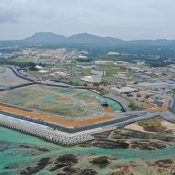
September 6, 2020 Ryukyu Shimpo
On September 3 and 4, ahead of regulations to restrict news reporting by drones over some of the U.S. military bases in Okinawa, Ryukyu Shimpo journalists captured aerial footage of Camp Hansen and the Camp Schwab coast, where the new Henoko base is under construction. No construction activities were visible, but the drone captured close-up views of the stone revetment built by the Okinawa Defense Bureau and a panoramic view of the construction site. It also shot footage of the Henoko Ordnance Ammunition Depot, which is being rebuilt, and Camp Hansen’s now-treeless exercise area.
(English translation by T&CT and Monica Shingaki)
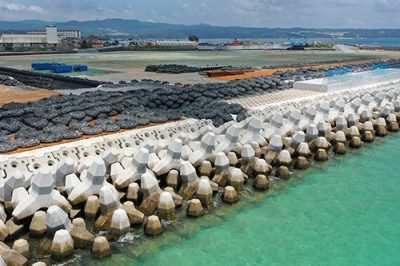
Concrete blocks stacked along the Camp Schwab coastline in Henoko, Nago City. Shot on the morning of Sep 4.
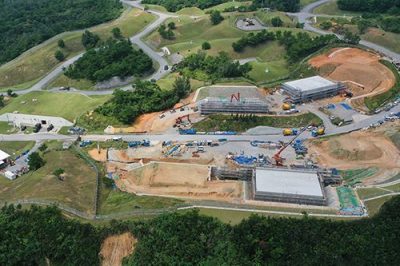
Construction workers rebuild the Henoko Ordnance Ammunition Depot (bottom) during the morning hours on Sep 4 at Camp Schwab in Henoko, Nago City.
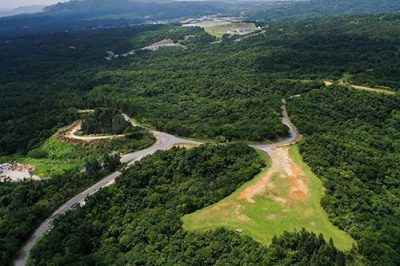
U.S. military exercise area located at Camp Schwab, shot in the afternoon on Sep 4 over Kanna, Ginoza Village.
Go to Japanese
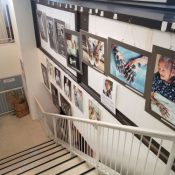
September 7, 2020 Ryukyu Shimpo Digital Edition
Tokyo – Former Ryukyu Shimpo photographer Hiroaki Yamashiro’s photography collection “Ryukyu Memory – Hajichi” which captures images of the hand tattoos, is on exhibit in Tokyo at Nobunkyo – Nobunsho Center (an agriculture specialty bookshop) in Kanda Jinbocho, and on the fourth floor of Junkudo Ikebukuro, celebrating the photographs’ publishing by Koubunken Co. Ltd. The exhibit will run through September 25 at the farming cultural association, and through the end of October at Junkudo.
At Nobunkyo, 28 of the published color and black-and-white pictures are on display on the walls of the staircase at the entrance. Shoppers at the bookstore stop to take in the pictures one by one, and some could even be seen snapping pictures with their smartphones.
In Okinawa, it was customary to tattoo the hands and arms of women during the Ryukyu Kingdom era, however after it was outlawed in 1899, and women with hajichi tattoos all but ceased to exist. Yamashiro has been taking photographs of women in Okinawa with hajichi tattoos since he was a student in college.
According to Nobunkyo staff, people are visiting the store in order to see the photographs. Seeing such a rare and almost extinct practice unique to Okinawa still draws a lot of eyes.
(English translation by T&CT and Sam Grieb)
Go to Japanese
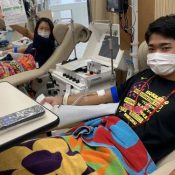
September 4, 2020 Ryukyu Shimpo
On August 21, second-year students of the Okinawa Prefectural Naha Nishi High School swim team donated blood at the Kumoji blood donation room in Kumoji, Naha City. While the novel coronavirus pandemic has kept her school from re-opening, Nirai Tamaki, 17, student manager of the swim team, convinced her team to “give back to the community since we can’t swim.”
Thanks to Tamaki’s initiative, a total of 9 students donated blood—Tamaki, seven swimmers, and Tamaki’s twin sister Kanai, who attends Naha High School. The athletes enjoyed a sense of accomplishment after donating blood—one commented, “Our blood may help someone in need.”
Tamaki became interested in donating blood after her mother, Sakie, 44, who is a nurse, talked to her about the shortage of blood during the ongoing pandemic. Tamaki then visited a blood donation center by herself in April but was too frightened to follow through with it.
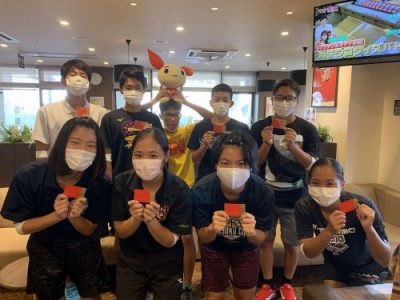
Nirai Tamaki (front row, 2nd from left) and members of the Naha Nishi High School swim team pose for the camera after donating blood.
Tamaki decided she would fare better in the company of friends and invited her teammates at gatherings and through LINE (a mobile messaging app) messages.
While Naha Nishi High School is temporarily closed and the swim team has not resumed practice, the coach buoyed up the swimmers and gave them the extra push: “After-school activities are available during times of peace. We should reflect on what we can do to help during a pandemic.”
On August 21, Tamaki was the first to volunteer her arm. “I was scared, but I figured everyone else must be terrified, so I went first. It didn’t hurt at all. I’m looking forward to doing it again.”
(English translation by T&CT and Monica Shingaki)
Go to Japanese
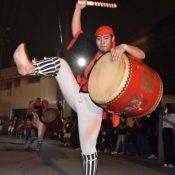
September 3, 2020 Ryukyu Shimpo
On September 2, Ukui, the final day of the Obon festival, the Okinawa City Kubota Youth Association performed the Eisa dance Michi Junei as a tribute to ancestors in the afterlife. Up through last year the Youth Association included a total of 40 people from around the region, but this year, in order to protect against the spread of the novel coronavirus, this number has been reduced to only about 15 people. Spectators kept their distance, and the space taken up by the procession was limited.
The sounds of taiko drums and sanshin reverberated in the air. Spectators could see the performance from the entryway to the festival, and clapped and whistled along with the beat. Tetsuya Yogi, 85, a spectator, said with a smile, “I feel uplifted. Perhaps the sound of the taiko even blew corona away”.
The head of the Youth Association, Reito Yagi, 21, with a sense of accomplishment, said, “Michi Junei is an important event to contribute to the region. Some people have even thanked us, and I’m so glad we could do this”.
In the average year, the residents’ association holds a Michi Junei performance during Obon, and many spectators visit from outside the city for the event. However, many did not visit this year due to the impact of the novel coronavirus. Several youth associations performed Eisa music, and chose to share their work by distributing videos of their performances.
(English translation by T&CT and Erin Jones)
Go to Japanese

August 30, 2020 Ryukyu Shimpo
An illustration of Shuri Castle created by a 6th grader in Nishinomiya, Hyogo has been eliciting great responses on social networking sites. The artist, Chihiro Yagyu, drew the piece hoping for the reconstruction of Shuri Castle, which burned down on October 31, 2019. The vibrantly colored piece will be used as the endpaper of the 2021 Okinawa Techo planner, issued by Okinawa Techo (located in Okinawa City). Yagyu says, “I poured my hope that people who saw the drawing would feel at least a little bit happier into the piece. I want to go see beautiful Shuri Castle when it is rebuilt.”
Yagyu has autism spectrum disorder (ASD). When he was 9, he began drawing using Copic sketch markers. In the 2019 Copic Award, an international contest, he won the Future Generation Art Prize.

Chihiro Yagyu
According to Nao Yagyu, Chihiro’s father, his son was shocked last October when he saw Shuri Castle burning on the news. That inspired Chihiro to draw the piece; beautifully symmetric with bright red roof tiles. Chihiro looked up the history of Shuri Castle before he began drawing. The piece was completed in December and he titled it “Until that Someday,” hoping for the castle’s reconstruction.
After posting the piece on a social networking site, Nao received comment after comment from people moved by the piece. “I feel like this piece will bolster my spirits until Shuri Castle is back to its beautiful self,” said one.
The Okinawa Techo planner in which the artwork will be used will go on sale on October 1. Chihiro Yagyu’s artwork is posted on the Twitter account nao-yagyu.
(English translation by T&CT and Ellen Huntley)
Go to Japanese
August 29, 2020 Ryukyu Shimpo
Prime Minister Shinzo Abe has announced his resignation. He was prime minister for seven years and eight months, since the inauguration of his second administration in December 2012. As his health worsened, he determined that it would be difficult to continue at his post.
At his press conference, Abe emphasized that “politics is about getting results,” but despite his long term as prime minister, his prime policy goals remain markedly unachieved.
Regarding Okinawa, Abe always repeated that he would “stand with the Okinawan people.” However, his administration has stood with Okinawans less than any other when it comes to the base issues. We hope to see an end to politics where power in numbers is used to bulldoze forward at the insistence that “this is the only way,” and a return to a politics that honors the will of the people.
After the inauguration of his second administration, Abe pushed forward his economic policy of “Abenomics” in an attempt to end deflation. His goal was to reach a GDP of 600 trillion JPY, but this goal has not been achieved. He put off his initial aim to improve fiscal health and achieve a surplus in the primary balance by 2020. He did not achieve his goal of “making women shine” by increasing the rate of women in leadership roles to 30% by 2020. He also failed to resolve the issues around the Northern Territories and the abduction problem.
Abe achieved consecutive wins in national elections and built a “one strong Abe” system. In 2017, however, the LDP failed to achieve 50% of votes in the Lower House election small electoral districts, yet nonetheless won more than 70% of Diet seats. This was the result of distortion in the present small electoral district system.
Even so, Abe used the win to argue that the people had placed their trust in his administration, and passed legislation on national security, protection of specified secrets, and “crimes of conspiracy” with disregard to deeply rooted opposition by the people. The arrogance bred by Abe’s long reign showed itself in the Moritomo and Kake scandals and the suspicion of misappropriation of the “cherry blossom-viewing party” held by the prime minister.
Around 70% of facilities for exclusive use by the U.S. military in Japan are located in Okinawa, and crimes and accidents resulting from the U.S. military are incessant. Attending the Okinawa Memorial Day ceremony by video call on June 23 of this year, the prime minister stated, “I am determined to achieve sure results toward reducing the base burden.” Meanwhile, he bulldozed forward with the new base construction in Henoko, Nago as part of the relocation of U.S. Marine Corps Air Station Futenma, asserting it was the “only solution.” He made no effort to negotiate with the U.S. to find a solution other than Henoko.
Abe increased and decreased the Okinawa-related budget depending on the position of the Okinawa prefectural administration on the U.S. base issues. He set up a new “Okinawa promotion special project advancement budget” which was directly negotiated by the national government with city and town mayors without going through the prefectural government, breeding local division. These policies embodied a “carrot and stick” approach.
In relation to the Henoko issue, in December of last year, a revised draft plan was announced that put the total construction cost at roughly 930 billion JPY, 2.7 times the originally planned cost, in order to address the weak sea floor 70 meters below the sea surface in the land reclamation zone. Nonetheless, prospects of completing the project are slim, from both a technological and a fiscal standpoint.
Prime Minister Eisaku Sato, who was Prime Minister Abe’s great uncle, declared to Chobyo Yara, the Chief Executive of the Government of the Ryukyu Islands, “we will not force Okinawa to bear the mainland’s burden (of bases)” (1971). Yet this promise remains unfulfilled today.
The Abe administration ignored the will of Okinawans against the new base construction in Henoko even as it was demonstrated in national elections, gubernatorial elections, and a prefectural referendum. His administration will surely go down in history as one that had no qualms making a farce of democracy and forcing the burden of U.S. bases onto a minority of citizens.
(English translation by T&CT and Sandi Aritza)
Go to Japanese















 Webcam(Kokusai Street)
Webcam(Kokusai Street)


